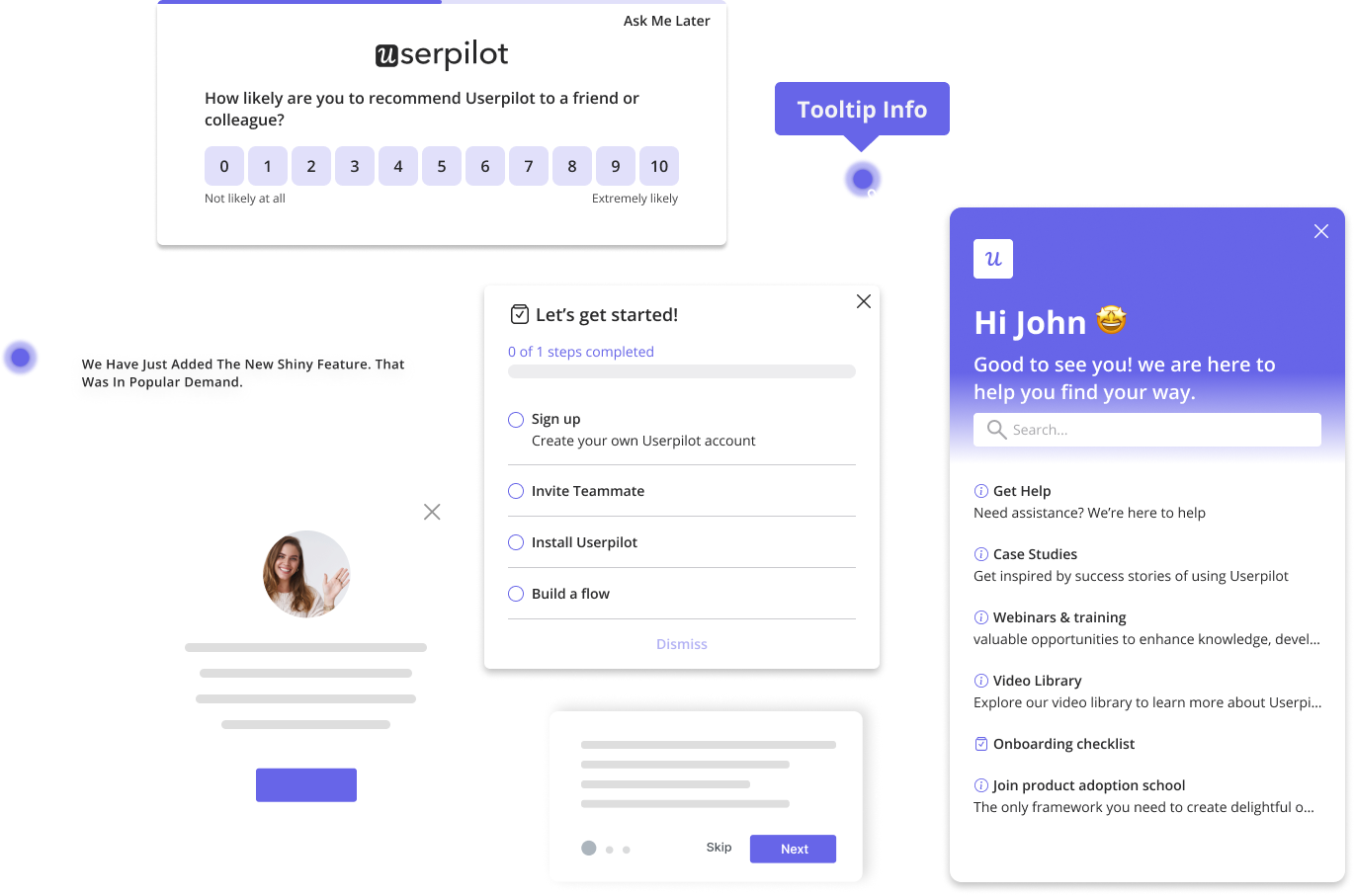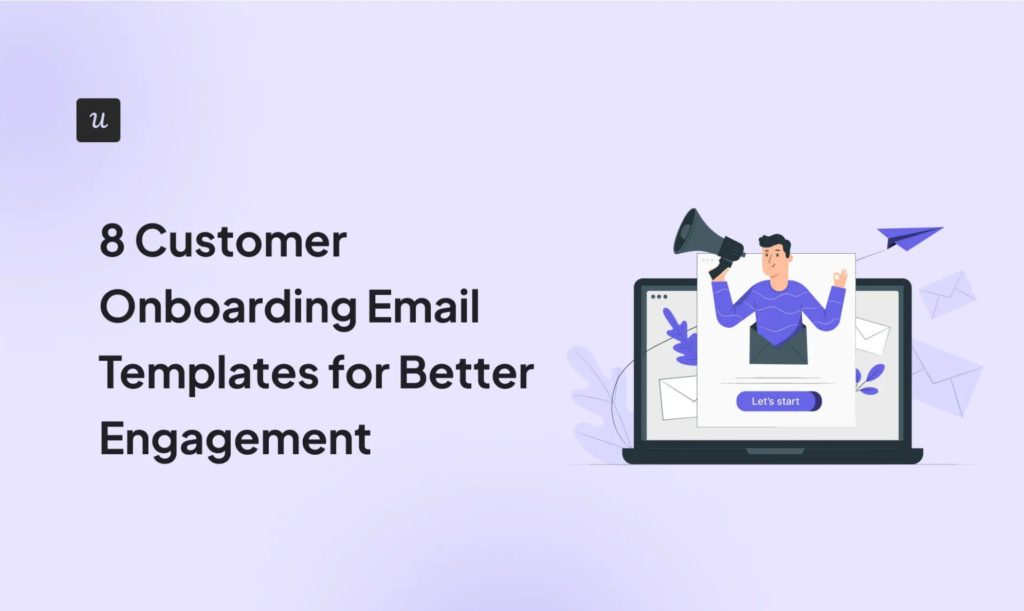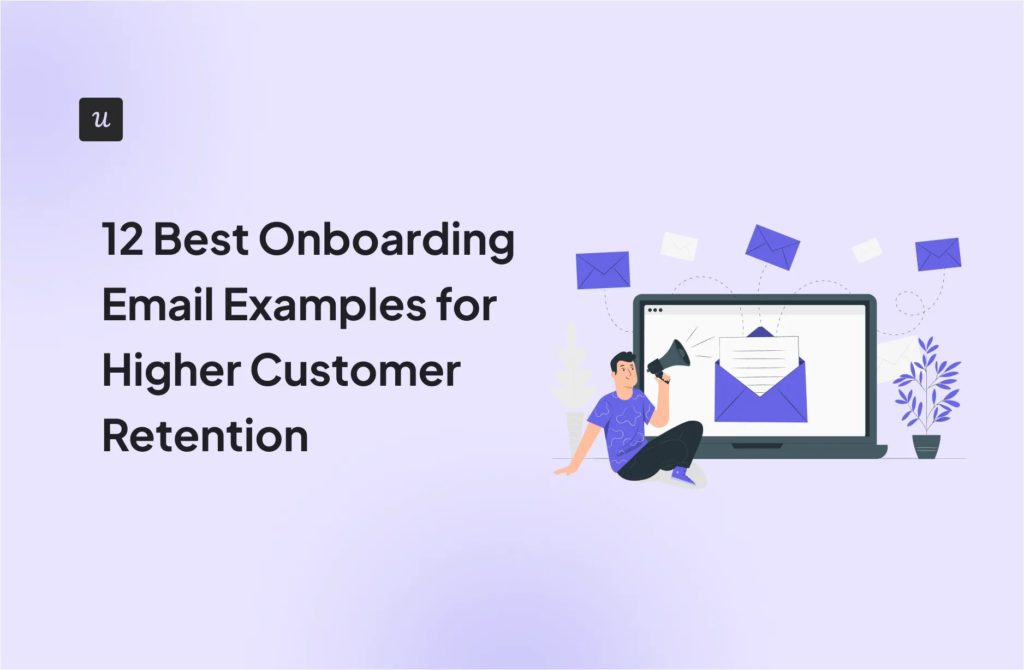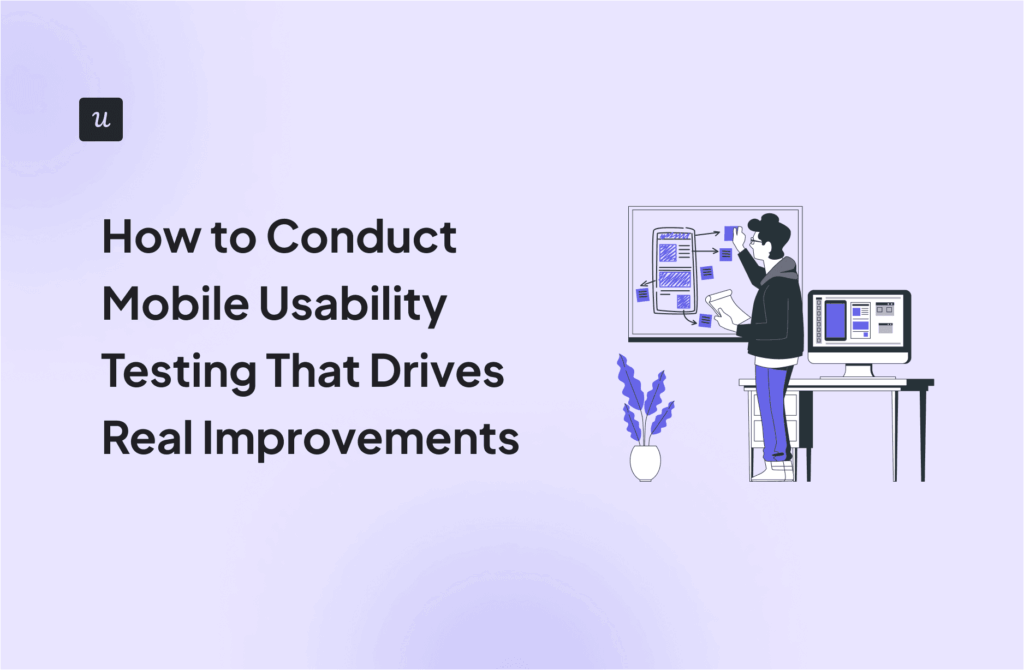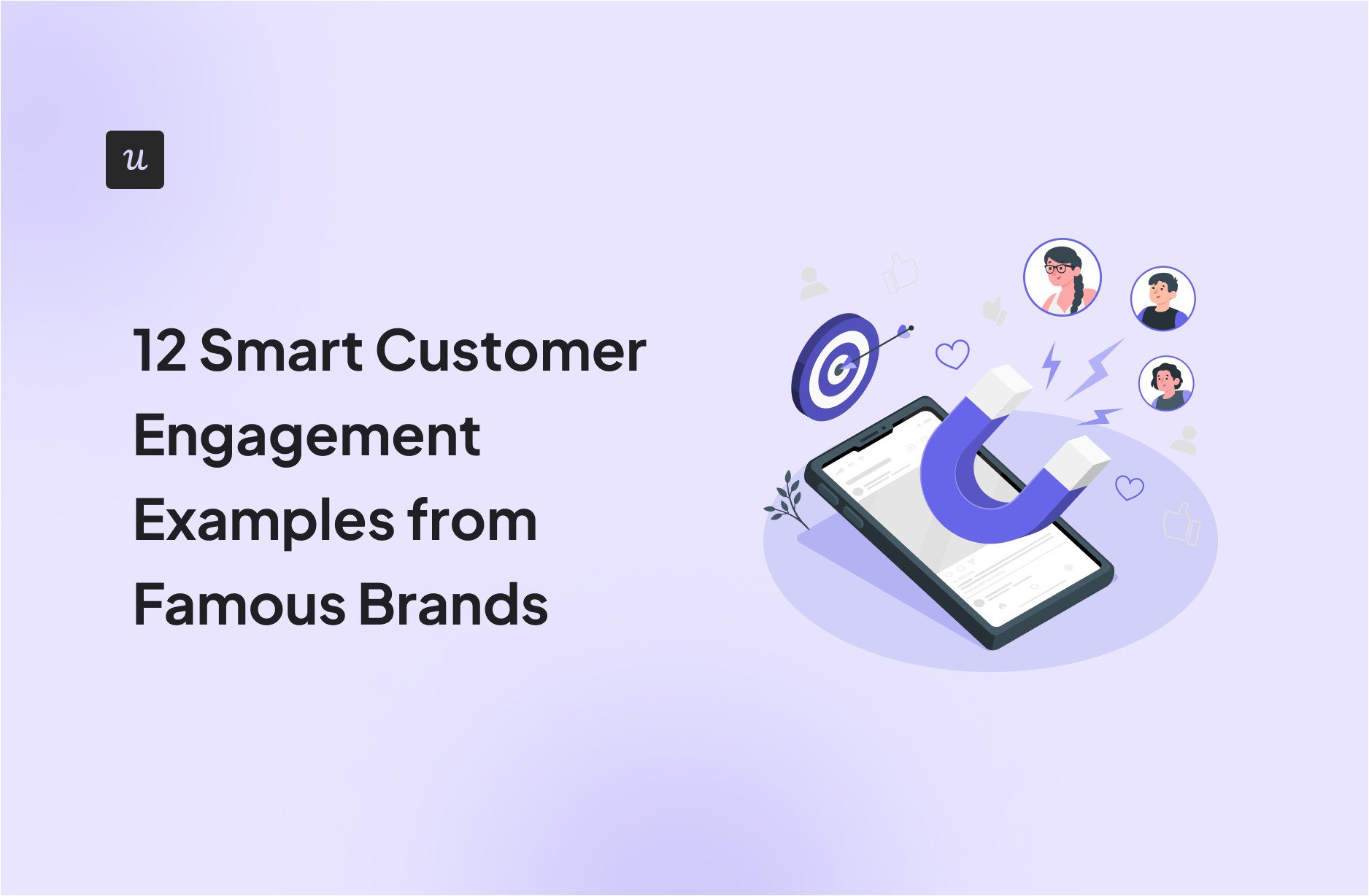
12 Smart Customer Engagement Examples from Famous Brands
Did you know that 84% of customers are more likely to do business with a company that provides personalized experiences? This statistic underscores the importance of customer engagement in business today.
In this article, we’ll explore 12 inspiring customer engagement examples by SaaS brands. We’ll also explore different customer engagement methods you can combine in your strategy.
Get The Insights!
The fastest way to learn about Product Growth, Management & Trends.
Different methods to drive customer engagement
Customer engagement is a versatile tool that can be used in different channels with 1 goal in mind: to retain customers.
But how do you engage customers without boring them? To answer that, we have compiled a list of effective elements you can use during different stages of the customer journey.
Welcome messages
It’s hard not to feel welcomed when you are greeted with a gamified welcome screen and a warm message.
Welcome messages typically appear in either (or both) of two places: The welcome screen users see the first time they launch your SaaS product…

…or in a welcome email used to introduce and guide new users through the product.

💡Why is this an effective method to drive engagement?
Warm welcome messages are like a warm smile and a friendly hello. Like a virtual handshake, they make your new customers feel valued from the start.
As you say hello, you can also introduce your product and show customers how it’s used for their specific use case. The result is a lasting first impression that sets the groundwork for customer activation and retention.
Customer onboarding checklist
After being welcomed to your product, users want to know where to get started. That is where the onboarding checklist comes in.
An onboarding checklist is a list of tasks a user needs to complete to get set up with your product and start using it.
A good onboarding checklist is brief and to the point, including only the most crucial steps. It should also provide clear instructions and use a progress bar to enable users to track their progress through the list.

💡 Why is this an effective method to drive engagement?
In addition to providing users with a sense of direction, a well-structured onboarding checklist keeps users motivated until they reach the activation point.
Onboarding checklists also leverage the Zeigarnik effect by creating a sense of incompleteness and cognitive tension, motivating users to complete the tasks and achieve a sense of closure.
Interactive walkthrough
Interactive walkthroughs are another type of engagement element. They provide users with step-by-step guidance.
Unlike product tours which can be tedious to follow, these walkthroughs are engaging as they help users learn by doing.

💡 Why is this an effective method to drive engagement?
Think of an interactive walkthrough as a personal tour guide. It takes customers by hand, showing them the key features and hidden gems of your product.
Much like when a friend shows you around town, it sets up these new users to easily find their way around your product. As a result, it reduces the user’s time to value and encourages speedy product adoption.
Want to get inspired? Check 9 inspiring interactive walkthrough examples we have put together.
Customer feedback surveys
How to know that your engagement strategy is working? Ask users how they feel about their experience.
Customer feedback surveys are excellent tools to do exactly that. They help you understand how users feel about the product and their experience. This gives you an idea of what to improve.

💡 Why is this an effective method to drive engagement?
A customer feedback survey is like a magic mirror that reflects your customers’ thoughts and feelings. It helps you understand what they love/hate and how you can make their experience even better.
For example, if a handful of users report struggling with a feature, you can offer them support via a 1-on-1 call with a customer success specialist.
Gamification elements
Ever wondered why we’re so hooked on games? It’s not just about the fun; it’s about the thrill of progress, the satisfaction of achievement, and the spirit of competition. So, we keep coming back for more.
Product gamification takes these elements from gaming and applies them to regular apps, websites, and learning experiences.
Progress bars, badges, and similar elements add a sprinkle of magic that makes your product more enjoyable and rewarding.

💡 Why is this an effective method to drive engagement?
Gamification makes the customer experience more fun, rewarding, and addictive. It taps into our innate desire to compete and achieve and, thus, encourages repeat usage and brand loyalty.
Duolingo, for example, uses streaks, leaderboards, hearts, badges/trophies, and other gamified challenges that offer unique rewards and create a sense of competition.
Who doesn’t love a challenge?
Milestone messages
Like gamification elements, milestone messages also tap into the human desire to achieve and succeed.
Milestone messages are warm celebratory messages acknowledging a noteworthy customer achievement or event.
It can be anything from an in-app message celebrating a significant product usage activity to an email wishing a customer a happy birthday.

💡 Why is this an effective method to drive engagement?
Milestone messages show customers that you care and that you’re paying attention to their activities. They’re like a virtual pat on the back, acknowledging the user’s progress and achievement.
As a result, they create a personal touch with users that fosters a sense of connection and drives customer loyalty.
Customer loyalty programs
Customer loyalty programs are like a secret society for your most dedicated fans. It’s a way of showing them some extra love and appreciation for sticking with your product.
They are like a VIP club where members get exclusive perks, rewards, and benefits. These incentives could come in the form of redeemable points, discounts, access to special features, or other exclusive deals.

💡 Why is this an effective method to drive engagement?
Who doesn’t love feeling special?
Customer loyalty programs are a way for you to say “thank you” to your most loyal customers. By offering meaningful and desirable rewards, you encourage users to keep choosing you over others.
The results are incredible! High-performing loyalty rewards increase the chances of a customer choosing your brand over the competition by almost 80%. It also increases their chances of recommending your brand by 117%.
In-app notifications
In-app notifications are a great tool for relaying timely information to an already-engaged customer. They are ideal for announcing new features, limited-time offers, webinar invites, and more.

Unlike emails or push notifications, in-app messages enable you to engage customers right where they are. For example, you can trigger modals or tooltips with contextual information based on a user’s actions.
💡 Why is this an effective method to drive engagement?
Think of in-app notifications as a personal assistant you provide to your users. They gently remind them about important updates or offers and provide useful information to them at just the right time.
For example, you can use it to remind a user that their free trial is ending. You can also send notifications within the context of the user’s in-app activity to drive customer engagement and satisfaction.
Social media channels
Social media enables you to connect directly with users. It enables you to engage customers in various ways, from posts to customer feedback collection and even user support.
If you’ve ever seen them, you’ll never forget Duolingo’s Instagram shenanigans and SEMRush’s LinkedIn memes.
These high-engagement posts help build a sprawling community of interested users for your product.

💡 Why is this an effective method to drive engagement?
Social media channels are like community centers where customers can connect, share experiences, and feel part of something bigger. But they are also an avenue for you to offer support to your customers.
Indeed, 95% of adults between ages 18 and 34 are likely to follow a brand through its social media channels. Similarly, 79% of customers expect a response within 24 hours on social media.
Therefore, providing excellent customer service on social media – especially within the public eye – massively boosts your marketing efforts.
Successful customer engagement examples to get you inspired
Now that you know different customer engagement methods you could include in your strategy, let’s consider some successful examples to inspire your own.
1. Beable Education improved user engagement and efficiency using Userpilot’s analytics and feedback features
Beable Education, an e-learning platform, originally struggled to demonstrate its product value and track user engagement effectively.
Recognizing the need for change, they embarked on a strategic initiative to unlock the full potential of their user interactions.

Beable improved user engagement by leveraging Userpilot’s no-code analytics and feedback tools.
They used feature tagging to track key product interactions, funnel analysis to measure content engagement, and in-app surveys to gather student feedback and boost participation by 77%.
They also optimized self-service support with resource center analytics, tailored to different user personas.
These insights allowed Beable to make data-driven decisions and enhance user experiences. For more details, you can explore the full case study here.
2. Zoezi improved customer communication and engagement with a help center
Zoezi, an all-in-one wellness platform, faced challenges in visibility and customer engagement.
Determined to improve, they implemented a comprehensive analytics strategy to gain deeper insights into user behavior.
Zoezi drew insights from Userpilot analytics to prioritize their development efforts. According to Isa Olsson, UX Researcher and Designer at Zoezi.
“Before Userpilot… we didn’t even know what pages people visited. Now we can just look at the pages tab and understand that people don’t use this stuff.”
Thanks to these insights, Zoezi revamped its in-product communication strategy. They introduced onboarding flows and strategic release notes, improving customer engagement and product adoption.
3. Talana improved customer engagement with proper onboarding
Talana, a human resource solutions company, improved customer engagement and satisfaction by addressing the shortcomings in their in-app communications and onboarding system.
💡 Key Takeaways:
- Talana created personalized checklists and interactive walkthroughs for its different user personas and features.

- To further support user autonomy, they created an in-app resource center to give users easy access to support articles and guides.

- The results were notable! Approximately 36% of Talana’s users actively engaged with the new in-app communications, a marked improvement from previous levels. Explore more in the case study.
4. Stripo improved the conversions by 32% with a successful customer engagement strategy
This customer engagement example is a tad different from the rest. Stripo Email drives engagement even before a user signs up for their service.
Their goal? Get users to the Aha! Moment (or activation point) as early as possible to encourage them to sign up.
- Stripo offered a one-click onboarding feature to enable potential users to understand the product and how it works without signing up.

- They also created an engaging checklist with interactive elements to make the product walkthrough an immersive experience.

- The results were impressive. Of over 31,000 site visitors, 32% engaged with the 1-click demo. 5% of these users also completed the full tutorial, indicating strong interest and high potential for conversion.
5. Attention Insight improved user activation by 47%
Attention Insight is an AI-powered tool offering attention heatmap analysis. Despite offering a free trial, they initially struggled to activate their users.
Note that the customer activation rate is a critical measure of customer engagement.
According to the CMO of Attention Insight, Darius Jokubaitis, only 47% of trial users reached activation, and only 12% engaged with one of the platform’s main features.

By creating and implementing new user onboarding flows, they improved the new user activation rate to 69% (a 47% relative increase!) and boosted engagement with the feature to 22%. For more details, read the case study.
6. Kontentino boosted user activation by 10% with a walkthrough and a checklist
Social media management platform, Kontentino, also identified new user activation and product adoption as key areas for improvement.
Recognizing the importance of first impressions in SaaS products, they focused on enhancing their new user experience.
Kontentino created an interactive walkthrough for new users. They also went a step further, incorporating a welcome survey to help them tailor the onboarding experience.

Within the first month of this addition, they observed a 10% increase in their activation rate. Check the results in the case study.
7. Userpilot engaged customers for usability testing
Userpilot’s UX researcher, Lisa, originally struggled with recruiting users for usability tests via email. So, she decided to engage customers in-app instead.
Lisa designed and implemented targeted surveys to help her recruit the right users for the tests.

Within a few days, she recruited 19 participants for the survey when she only needed 5.
You can read more about this example here.
8. Google uses engagement loops
An engagement loop is an experience that motivates users to continue to the next step, which provides additional reinforcement to keep the cycle of engagement going.
Google powers its engagement loop with its Google Workspace ecosystem of tools, cleverly designed to keep users coming back.

9. Wise uses feedback collection to engage customers
Money transfer platform, Wise, provides an excellent customer engagement example with its feedback collection system. While it may seem rather simple, this example contains some noteworthy lessons.
Wise keeps its NPS survey short, simple, and sweet, making it easy for users to respond quickly.

10. Todoist uses gamification in customer interactions
For Todoist, the goal has always been to make to-do list management a fun process to encourage continued app usage. To achieve this goal, they rely heavily on gamification.
Firstly, Todoist uses gamification elements to give users a sense of progress that keeps them returning to the app.
Their “Karma points” system also encourages new users to stick with their app, while helping existing ones track their goals.

11. Semrush’s social media success
Social media is an excellent driver of brand engagement and Semrush takes full advantage of it. They recognized LinkedIn as the ideal tool for businesses and set about exploiting it.
First, Semrush optimized its LinkedIn headline and “About” section to highlight its impact and mission.

They also engage customers on their page by replying to comments and posting interactive content regularly.

As a result of this strategic use of LinkedIn, Semrush has gained over 470K followers on the platform.
12. Grammarly reengages inactive customers with its email marketing strategy
Grammarly’s edit and writing services are integrated into other apps using plugins, meaning few users have any need to visit the core Grammarly platform.
As a result, Grammarly adopts an omnichannel customer engagement strategy.
Grammarly periodically sends emails to active customers with metrics that show their performance and progress.
For inactive customers, Grammarly sends re-engagement emails to return their attention to the platform’s features.

Grammarly’s successful customer engagement example is a beacon for products whose primary use case is found within other products.
Create similar customer engagement examples with Userpilot
Userpilot is a powerful product adoption platform designed to help businesses improve customer engagement, product adoption, and retention.
It provides various features to that effect, including:
- User onboarding: Create interactive walkthroughs, tooltips, modals, and checklists to help new users understand and navigate your product.
- In-app surveys: Collect user feedback on specific features, user experiences, and satisfaction levels. You can also create and analyze NPS surveys from a dedicated dashboard.
- Analytics: Monitor user engagement metrics to understand your product users. You can also track feature adoption, retention, and other metrics to help you identify areas for improvement.
- Segmentation: Segment users based on demographics, in-app behavior, and more. You can then create targeted campaigns that address a segment’s needs or automate actions based on events.
Over 1000 companies are using Userpilot today to accelerate product growth, including some customer engagement examples cited above. Book a demo today to see what makes it an excellent choice.

Conclusion
As you can see, direct customer engagement is the best way to ensure continuous growth. Customer satisfaction depends on how engaged users are.
Userpilot can help you drive this engagement with its feedback collection, product analytics, and user onboarding features. Want to learn more? Book a demo today!
Customer Engagement FAQs
What is customer engagement?
Customer engagement refers to the ongoing interactions between a business and its customers.
It involves building meaningful customer relationships, encouraging active participation with your brand/product, and creating an emotional or rational connection with customers.
What does customer engagement include?
Customer engagement includes understanding customer needs, personalizing their experiences to suit those needs, and providing value. Good customer engagement strategies also include active listening to customers.
What is a good customer engagement score?
A “good” customer engagement score can vary depending on the industry, company size, and specific metrics used. If you’re measuring the percentage of users who engage with a core feature, for example, the closer you are to 100%, the better.
What are the 5 stages of customer engagement?
Customer engagement is a journey that involves five key stages: Awareness (or Discovery), Consideration, Purchase, Loyalty, and Advocacy. Therefore, an effective customer engagement strategy aims to move customers through these stages and build lasting relationships.
What are the 4 P’s of customer engagement?
The four P’s of customer engagement are personalization, proactivity, people, and problem-solving. They refer to different facets of customer engagement or customer service that make the experience pleasant for the user.

